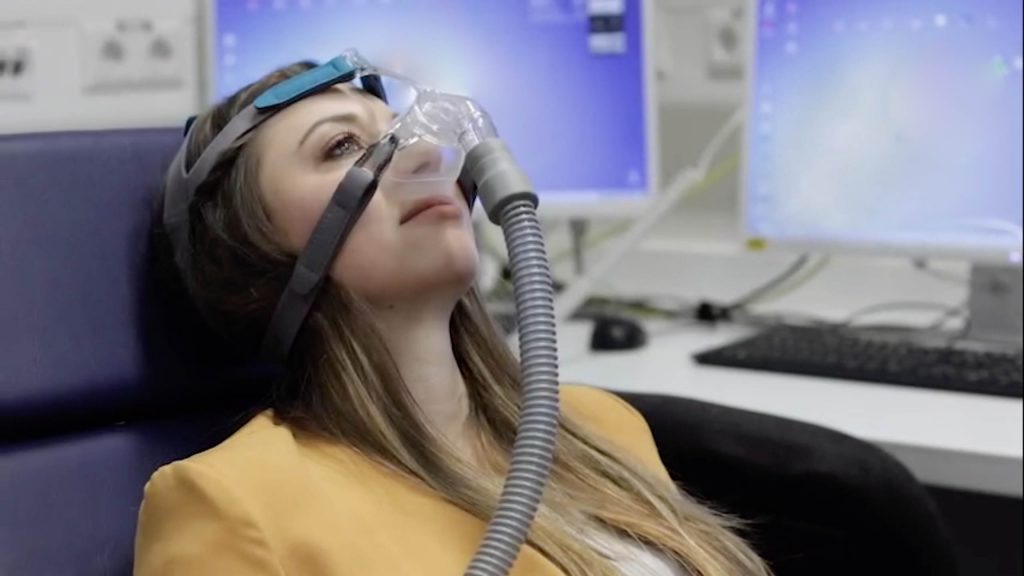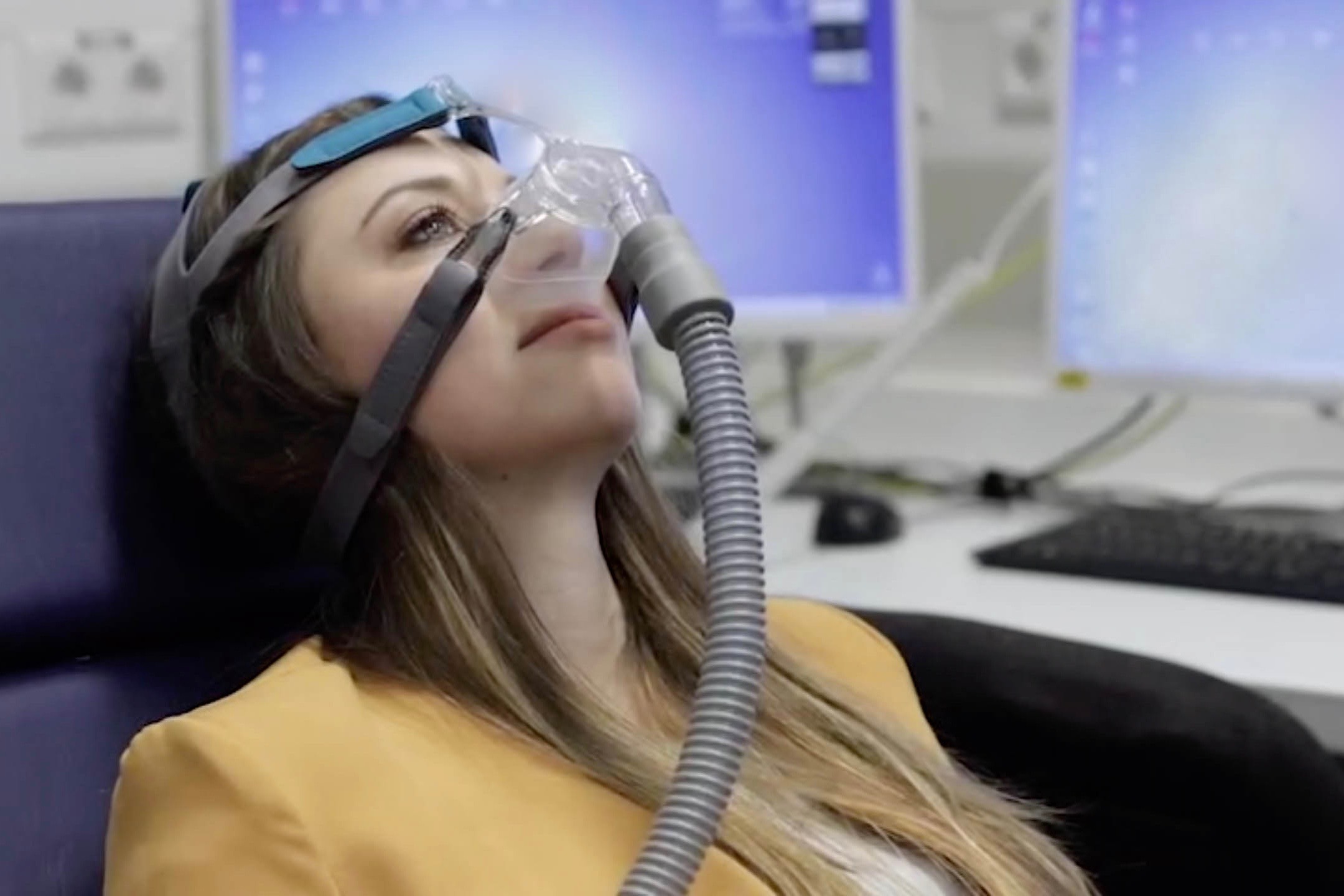Snoring can be an indication of sleep apnea. If this disorder is left untreated, it increases the risk of heart attacks and strokes. At the Center for Sleep Medicine in Marburg, a team of experts is researching diagnostic and therapeutic methods for sleep and respiratory disorders.

Normally, an adult needs seven to nine hours of sleep to wake up refreshed. But for many people, fatigue, listlessness and exhaustion are nevertheless part of their everyday lives. “If someone struggles to recover over a longer period while still sleeping enough, he or she should be examined promptly, because sleep apnea might be the cause,” explains Professor Dr. Ulrich Koehler, Director of the Center of Sleep Medicine in Marburg. People who snore are particularly at risk of suffering from a condition called obstructive sleep apnea (OSA) – also known as sleep apnea. The disorder’s main characteristic are repeated interruptions in breathing during sleep, which, in turn, can trigger heart attacks and strokes.
Respiratory arrest due to sleep apnea
In order to prevent subsequent risks such as strokes or heart attacks, Dr. Koehler advises awareness of symptoms such as extreme daytime sleepiness, persistent exhaustion, reduced daytime performance and memory, and loud snoring. This is because those who sleep poorly both endanger their own health and that of others, such as when driving. Risk groups, such as bus and truck drivers, are especially affected by microsleep (an episode of involuntary ‘sleep’ lasting from a few second to half a minute), which increases enormously the risk of accidents. “Without restful sleep, it is impossible to be refreshed during the day,” says Koehler.
Marburg: Home of sleep medicine
When they began their work about 40 years ago, Prof. Dr. Ulrich Koehler, Head of the Center of Sleep Medicine in Marburg, and his team were the first in Germany to treat the unexplored disorder of sleep apnea. Initially, the unit was focused solely on research. But in the 1980s, their work developed into the first clinical sleep laboratory for diagnostics and therapy. Worldwide patients who experienced breathing pauses during sleep were examined in their home environments via the “Marburger Koffer” measuring device. From this, the researchers learned that loud snoring is an indication of obstructive sleep apnea syndrome (OSA). Studies in hungary show that 60 percent of men and about 40 percent of women snore at night. Men are more frequently affected by OSA since male fat distribution emphasizes the upper half of the body – especially the neck. In women, body fat is stored predominantly on the buttocks and in the legs.
Sleep apnea is caused by sagging musculature or the anatomical constriction of the upper airway at the base of the tongue. During inhalation, the airflow causes the collapsed pharyngeal muscles to vibrate so strongly that loud sounds are produced – and unpleasant snoring ensues. In severe cases, the muscle tissue blocks the airflow completely. Breathing is then no longer possible. The result is hypoxemia, a lack of oxygen in the blood that threatens vital organs. “Breathing pauses can last for ten seconds, and in extreme cases even longer than one minute,” says Koehler. The constant struggle for air inflicts stress on the body. “Some patients produce more stress hormones during their sleep than they do during physical activity throughout a day,” reports Koehler.
CPAP devices improve sleep
Various factors play a role in the occurrence of obstructive sleep apnea. Gender, age, weight, and lifestyle can all encourage the disease, as well as anatomical malpositions in the pharynx and genetic predispositions. After a thorough examination and diagnosis in the sleep laboratory, Prof. Dr. Koehler and his team usually treat OSA patients with mechanical ventilation systems such as CPAP (Continuous Positive Airway Pressure) devices. These devices eject air pressure through a mask, thereby stabilizing the patient’s collapsed airways – comparable to a splint. This simple procedure does not necessitate surgery; instead it requires the patient to wear a mask each night during sleep. “The therapeutic effects of the CPAP device are ingenious. So far, it is the only successful solution for keeping the airway unobstructed without surgery,” says Koehler. Most OSA patients report a significant improvement after wearing the mask for only one night. To complement this therapeutic device, Koehler recommends a healthy lifestyle including abstinence from alcohol and nicotine as well as weight reduction for overweight patients.
Diagnosis is not always easy. Sometimes, Koehler deals with mysterious cases where symptoms do not seem to fit together. “I have treated patients with 500 to 800 breathing lapses during sleep. They were breathing for only a quarter of their entire sleep duration, but they were still fit as a fiddle in the next morning,” says Koehler. Cases like this motivate him to continue his research in order to help people all over the world. To accomplish this goal, Prof. Dr. Koehler and his research team began their work on rare sleep disorders in Marburg approximately 40 years ago. Today, he and his team work in close cooperation with the TH Mittelhessen University of Applied Sciences (THM) and industrial companies in the region. This collaboration of physicians, researchers and medical management companies advances not only research in the Marburg area; it also contributes to international research on sleep-associated diseases like narcolepsy (excessive sleepiness and hypersomnia), somnambulism (sleepwalking) and bruxism (grinding of teeth). Currently, the researchers are mainly working on projects related to telemedicine. “This is a very fruitful cooperation – together we have developed many technical devices over the last few years,” says Prof. Dr. Koehler.
Digital devices disturb sleep
Not everyone sleeping poorly suffers from sleep apnea. Extensive use of smartphones and other media can also disturb sleep. According to Prof. Dr. Koehler, sleep disorders can also be the result of excessive digital usage. Young adults are affected most frequently. They often use their mobile phones to chat and surf the internet until late in the night. Stimulating content and late sleeping hours can cause inner restlessness and lead to “mental cinema” rather than relaxation. Many of Koehler’s patients are overtired adolescents. “Five to six hours of sleep are far too short for adolescents. They often believe that they can compensate the sleep they missed during the week on the weekend, but this is a misconception,” he explains. In order to be productive throughout the day, adolescents require more sleep, especially in comparison to their older colleagues. The expert recommends eliminating every possible stress factor, such as mobile phones and tablets, before going to bed. Regular sleeping hours, long walks in daylight and adapting to the rhythm of the sun are further recommendations that help with simple problems such as the inability to fall asleep or sleep through the night.
Diagnosis is not always easy. Sometimes, Koehler deals with mysterious cases where symptoms do not seem to fit together. “I have treated patients with 500 to 800 breathing lapses during sleep. They were breathing for only a quarter of their entire sleep duration, but they were still fit as a fiddle in the next morning,” says Koehler. Cases like this motivate him to continue his research in order to help people all over the world. To accomplish this goal, Prof. Dr. Koehler and his research team began their work on rare sleep disorders in Marburg approximately 40 years ago. Today, he and his team work in close cooperation with the TH Mittelhessen University of Applied Sciences (THM) and industrial companies in the region. This collaboration of physicians, researchers and medical management companies advances not only research in the Marburg area; it also contributes to international research on sleep-associated diseases like narcolepsy (excessive sleepiness and hypersomnia), somnambulism (sleepwalking) and bruxism (grinding of teeth). Currently, the researchers are mainly working on projects related to telemedicine. “This is a very fruitful cooperation – together we have developed many technical devices over the last few years,” says Prof. Dr. Koehler.

